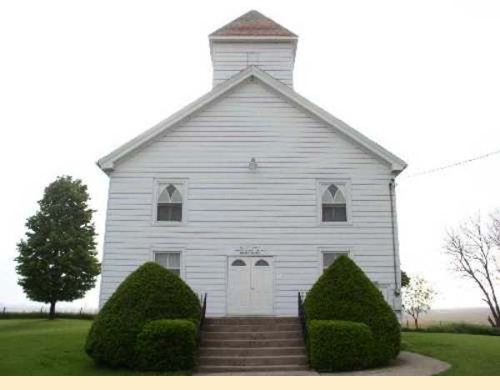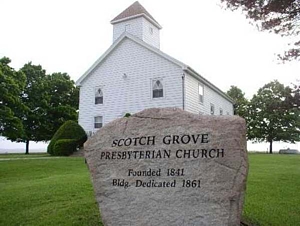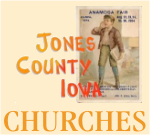
It is just as natural for a Highland Scotchman to be a Presbyterian, as it is for a south of Ireland man to be a Catholic. And it was very appropriate that the Highland Scotch who were the first to settle in Scotch Grove should organize a Presbyterian church.
As early as 1837-38, Rev. Michael Hummer, a somewhat eccentric man, visited Scotch Grove looking up the stray Presbyterians. He journeyed on horse back and was gladly welcomed by the early settlers.
In June, 1841, the First Presbyterian Church of Edinburg was organized with twelve members as follows: John Sutherland and Margaret (McBeath), his wife, Donald Sinclair and Ann, his wife, James Livingston and Sarah, his wife, David Esson and Margaret, his wife, Sarah Sutherland, Alexander McClain. Donald Livingston and Ann, his wife. Donald Livingston and John Sutherland were elected ruling elders. From 1843, the church was visited five or six times a year for seven years by Rev. Salmon Cowles of West Point, Lee county, about one hundred and thirty miles distant. From the spring of 1849 to tne of 1850, Rev. F. A. Pratt, served as minister, his wife teaching school in a room of Ebenezer Sutherland's house. The town of Edinburg having failed to grow. Ebenezer Sutherland offered to the church seven acres of land on the northeast corner of his farm for church purposes and also for a cemetery, where the Presbyterian church and cemetery are now established. This offer was accepted as most of the membership was on that side of the prairie.
In the summer of 1851, a church building was erected a few rods northeast of where the Soldier's Monument now stands in the cemetery. Rev. James Galitin, a relative of the Swiss Galitins of Pennsylvania, began preaching in Scotch Grove, May 1. 1850. Money was scarce and the labor and expense of erecting a frame building was burdensome. With true Scotch devotion to the cause. Donald Livingston and Ebenezer Sutherland advanced two hundred dollars to pay for doors, windows and other fittings that had to be paid for in money. This offer, in a time when interest rates were usually from twenty-five to thirty per cent, meant a great deal more than it would mean in the present day. Neither principal nor interest were ever repaid, but when the present church edifice was erected in 1861, the debt was freely forgiven and the obligation canceled.
From the records, we find that the name of the church was changed from Edinburg to Scotch Grove in 1852. Rev. Galitin died suddenly May 1, 1856, and in October of that year, Rev. J. L. Wilson came as stated supply, and continued in that relation to the church till January, 1873. During his ministry, the present church was built in 1861. It cost about two thousand dollars, and was paid for entirely by the congregation without any outside help. This in fact is Scotch Grove's way of doing things. Whenever any extra money was needed for church work, the members went a little deeper into their own pockets and always had it to give.
 Rev. Wilson also preached at the Paul schoolhouse in Wyoming township, once in two weeks, from June 16, 1861 till the close of 1874. The session of the Scotch Grove church meeting there and admitting members and administering the sacraments. We find the names of the Paul's, the Streeper's, Tasker's, Wasson's, Frank's, McGrew's, Duncanson's, Kirkpatrick's, Woodyard's, and others as being added to the church roll at that time. Rev. Wilson also preached a part of this time at a schoolhouse south of where Bethel church now stands in Clay township. And also at Canton, Ozark and Cascade.
Rev. Wilson also preached at the Paul schoolhouse in Wyoming township, once in two weeks, from June 16, 1861 till the close of 1874. The session of the Scotch Grove church meeting there and admitting members and administering the sacraments. We find the names of the Paul's, the Streeper's, Tasker's, Wasson's, Frank's, McGrew's, Duncanson's, Kirkpatrick's, Woodyard's, and others as being added to the church roll at that time. Rev. Wilson also preached a part of this time at a schoolhouse south of where Bethel church now stands in Clay township. And also at Canton, Ozark and Cascade.
From 1873, Rev. John Rice preached at Scotch Grove Sabbath mornings, and in the afternoons part of the time at Onslow, and at the Wayne church, and in the later part of his ministry, at Bethel.
Beginning again in 1879, Rev. Wilson preached for five years. In 1886 and 1887, Rev. William Gay was the minister in charge. Rev. J. F. Montman preached in 1889. From 1891 to 1894, Rev. Hugh Robinson was pastor. It was during the pastorate of Rev. Mr. Robinson that the parsonage was built. From 1895 to 1898, Rev. J. M. Bolton. From 1900 to 1901, Rev. T. W. Hine. Wm. M. Dagar preached a part of 1901 and 1902, just before he went as a missionary to west Africa. From 1902 to 1904, Rev. R. M. Offut. Rev. R. A. Brough is the present pastor. Mr. Brough was the moderator elect of the Presbytery of Cedar Rapids the present year.
The elders of the church since its earliest organization, have been: John Sutherland and Donald Livingston at the organization; David M., Cook, James Clark and Matthew Dawson were added in 1856; Robert B. McCullough in 1858; John Bently and Hugh C. McKean in 1859; S. H. Clark and Lyman Hoyt in 1862; Thomas Lyans and William Clark in 1866; David Sutherland in 1871; Alexander McKean in 1881; James Espy in 1884; C. B. McKean in 1890; Mathias Sweesy in 1892; William Sutherland in 1896; W. B. Warner and S. J. Rice in 1907.
This church has been the mother of several churches of the same denomination. The church at Onslow was originally a part of the Scotch Grove church. The Center Junction church was composed to a large extent of members of the Scotch Grove church who lived in the neighborhood of the new town. Bethel likewise and also the Wayne church enjoyed the membership of this pioneer church.
The present church organization: pastor, Rev. R. A. Brough; elders: William Sutherland, W. B. Warner, S. J. Rice; deacons: D. O. Sinclair, G. J. Hughes; corporation officers: E. C. Hughes, chairman; clerk, S. J. Rice; cemetery committee: D. O. Sinclair, G. J. Hughes, S. J. Rice, the latter being clerk and treasurer of committee; church treasurer, Mrs. H. B. Sutherland; Sunday-school officers: superintendent, William Sutherland; secretary and treasurer, Miss Blanche Clark; primary superintendent, Mrs. D. O. Sinclair; sunbeam mission band : president, Willie Carson; vice-president, Frank Himebaugh; secretary, Lillie Heinrichs; treasurer, Orel Hutton; ladies missionary society: president, Mrs. L. M. Rice; vice-president, Mrs. Alicia Clark; secretary and treasurer, Mrs. D. O. Sinclair; secretary of literature, Della Sutherland. A somewhat unusual arrangement of the Sabbath school is, that all contributions are divided between home and foreign missions, and the running expenses of the school are provided for by the older people.






